Related Research Articles

Cheddar cheese is a relatively hard, off-white, sometimes sharp-tasting, natural cheese. Originating in the English village of Cheddar in Somerset, cheeses of this style are now produced beyond the region and in several countries around the world.
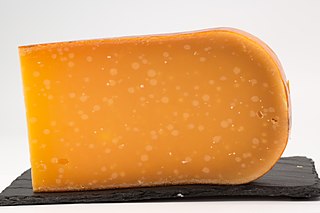
Gouda is a mild-flavored, yellow cow's milk cheese originating from the Netherlands. It is one of the most popular cheeses worldwide. The name is used today as a general term for numerous similar cheeses produced in the traditional Dutch manner.

Caerphilly is a hard, crumbly white cheese that originated in the area around the town of Caerphilly, Wales. It is thought to have been created to provide food for the local coal miners. The Caerphilly of that period had a greater moisture content, and was made in local farms. At the start of the 20th century, competition for milk in the local area saw production decline, and Caerphilly production was gradually relocated to England.

Parmigiano-Reggiano or Parmesan is an Italian hard, granular cheese that is produced from cow's milk and has aged 12–36 months.

Lancashire is an English cow's-milk cheese from the county of Lancashire. There are three distinct varieties of Lancashire cheese. Young Creamy Lancashire and mature Tasty Lancashire are produced by a traditional method, whereas Crumbly Lancashire is a more recent creation suitable for mass production.

Saint-Nectaire is a French cheese made in the Auvergne region of central France.
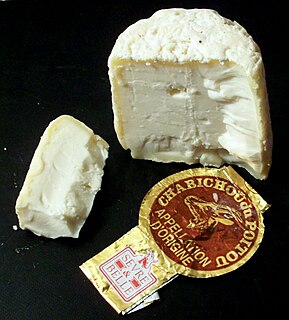
Chabichou is a traditional soft, unpasteurized, natural-rind French goat cheese with a firm and creamy texture. Chabichou is aged for 10 to 20 days.

Caprino is an Italian cheese traditionally made from whole or skim goat's milk. The name of the cheese derives from the Italian word for goat, capra. With modern methods of production, the cheese is made from cow's milk as well or a combination of both cow's and goat's milks. The two major styles of caprino are fresco (fresh) and stagionato (aged).
Abbaye de Tamié is a soft cheese made from unpasteurised cow's milk, similar in style to Reblochon and produced exclusively by the monks of Tamié Abbey, near to Albertville in the Savoie département, in the French Alps.

Swaledale is a full fat hard cheese produced in the town of Richmond in Swaledale, North Yorkshire, England. The cheese is produced from cows’ milk, Swaledale sheep's milk and goats’ milk.

The Pallone di Gravina is a firm, semi-hard, cow's milk cheese from the regions of Basilicata and Apulia in south-east Italy. It is made in the pasta filata style weighing between 1.5 and 2.5 kg, in a pear-like shape, ball or balloon (pallone), and was traditionally produced in the area of the city of Gravina, in the Murgia area of the province of Bari. Today, however, production is centred on the province of Matera.
Alpujarras cheese is a Spanish cheese from the eastern region of Andalusia, which includes the provinces of Granada, Almería and the Penibética mountain chain. The cheese takes its name from La Alpujarra, a mountainous region which occupies a part of southern Granada province and western Almeria province. This area has a long history and tradition of goatherding. Alpujarras cheese is made from the milk of the White Andalusian domesticated goat.

Casín cheese is a Spanish cheese made in the Principality of Asturias. Its name is covered by a protected designation of origin (PDO). It is made from full-fat, unpasteurized cows' milk from specific breeds, namely Asturian Mountain, Asturian Valley (Asturiana de la Valles), Friesian and any crosses between these breeds. Specifically the geographic area of manufacture is the southern part of Asturias which includes the Redes Natural Park and associated land, this is within the municipalities of Caso, Sobrescobio and Piloña. The cheese is classified as hard and semi-hard, and can be semi-cured or cured. It takes its name from one of the breeds of cattle whose milk is used, in turn named after the town of Caso. The shape of the cheese is a thick disc-shape, sometime more conical, of 10–20 cm diameter and 4–7 cm in height. The weight is between 250 and 1,000 g.

Flor de Guía cheese is a Spanish cheese made on the island of Gran Canaria in the Canary Islands. It has Denomination of Origin protection. The cheese is classified as fatty or semi-fatty and made from the milk from Canarian sheep, with milk from Canarian cows and/or goats. The milk from the sheep must constitute at least 60% and cows’ milk content must never exceed 40%. Goat milk must never exceed 10% of the mixture. The cheese is presented in flat cylindrical cheeses which normally measure 4–8 cm high and 20-30 cm across and weighing between 2 and 5 kg. The cheese gets its name from an area in northern Gran Canaria called Santa María de Guia, where the cheese is made, and ‘flor’ from the fact that juice from the flowerheads of a species of cardoon and globe artichoke are used to curdle the milk.
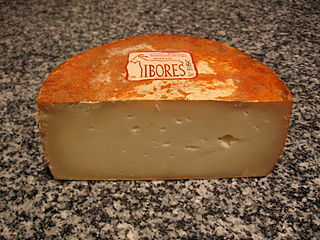
The Ibores cheese is a Spanish cheese made from unpasteurized goats’ milk in Extremadura. It has a Denomination of Origin protection in the European Union and is made specifically in the districts of Ibores, Villuercas, La Jara y Trujillo in the south east of the Province of Cáceres. It is a fatty cheese made exclusively from the milk of Serrana, Verata, Retinta breeds and crosses between them and only from farms registered with the regulatory council. The cheeses are flat cylindrical and measure 5-9 cm (2-3.5 inches) high and 11-15 cm (4-6 inches) across. They weigh from 600-1200 g (1-2 lbs).
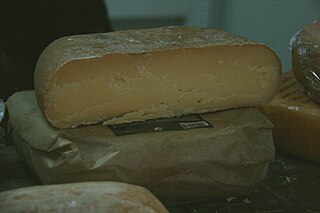
Mallorca cheese is a Spanish cheese made exclusively on the island of Mallorca, one of the Balearic Islands in the Mediterranean Sea. It has Protected Designation of Origin and is made from the pasteurized milk of cows, goats and/or sheep which live on the island. The cheeses are slightly tapering, flat cylinders which measure 12–20 cm (5-8 inches) across and 7-9 cm (3-4 inches) high. They weigh from 750 g to 4 kg (1.5-9 lbs). Mallorca cheese is produced in three types:
Murcian cheese is a fatty goats' milk cheese from the Murcia region of south-east Spain. It has a Protected Designation of Origin. The cheese is made only from milk from goats of the Murcian breed from registered herds which graze freely on scrub and coarse pasture characteristic of that dry geographical zone. The cheese is made in two forms:

'Kopanisti is a salty, spicy cheese, with protected designation of origin (PDO) produced in the Greek islands of the Cyclades in the Aegean Sea such as Mykonos, Tinos, Andros, Syros, Naxos etc; it has been produced in Mykonos for more than 300 years. It owes its special peppery and spicy taste to rapid and extensive lipolysis and proteolysis caused by abundant microbial growth encouraged by repeated kneadings performed during the ripening process.
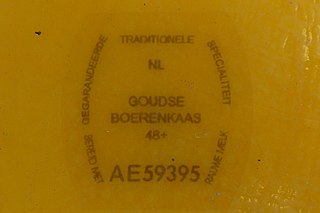
Boerenkaas is a Dutch cheese, most of which is handmade from raw milk from cattle, goats, sheep or buffalo. Cheese may contain also cumin or other seeds, herbs, and spices.
References
- 1 2 "EU Protected Food Names Scheme — UK registered names, National application No: 01313 — Teviotdale Cheese". Defra, UK — Department for Environment Food and Rural Affairs. 21 July 2003. Archived from the original on 27 February 2014. Retrieved 2012-02-17.
- ↑ UK Protected Foods Archived 2012-05-12 at the Wayback Machine